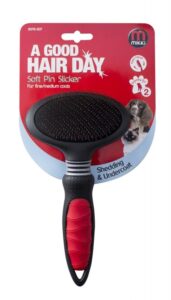As the UK enters its third national lockdown, many dog owners are left wondering whether or not to take on dog-grooming at home. While it’s possible to take on some basic doggy fur maintenance yourself, you might need a little helping paw from a professional. Luckily, professional dog groomer for Burns Pet Nutrition, Jackie Bowen, is here to give us her top tips on dog grooming for beginners.
Can I Groom My Dog Myself?
You can groom your dog yourself at home, but you need to have a few basic skills and knowledge of best practices to make sure you and your pooch are as safe and comfortable as possible. Perhaps one of the most important factors to dog-grooming at home is making sure you have the right tools. This is why a good dog grooming brush is every professional groomer’s best friend.
What Brush Should I be Using?
One of the questions I get asked all the time, is ‘what brush should I be using?’ Well, it largely depends on the kind of coat your dog has. For breeds such as cockerpoo, bichon, poodle and all the in-between breeds, there is really only one dog grooming brush I’d recommend: The Slicker Brush.

Dog Grooming Slicker Brush
The slicker brush is the dog groomers go-to brush. It can be both flat and curved, and it can also have a hard plastic backing or cushioned backing with close-set, angled wire teeth that are either firm or soft, depending on what you need it for. Slicker brushes are the best brushes for shedding, and suitable for most coats, except those with short hair. My recommendation for breeds with short hair is a curved, cushioned slicker brush, mainly because using a hard, plastic-backed slicker brush will be uncomfortable for them, and may lead to them not wanting to be brushed.
Buying a New Slicker Brush for Dogs
When you’ve decided on the perfect slicker brush to groom your dog, it’s important to remember that the pins can be quite hard at first and will need to be worn in. This is because over-use of a harder slicker brush can lead to abrasions on your dog’s skin, more commonly known as ‘slicker burn’ or ‘brush burn.’ These issues can potentially lead to severe problems when your dog starts licking and chewing the affected area, opening them up to a possible secondary infection.
How to Hold Your Slicker Brush
Using and holding the slicker brush in the correct way will help you get the best results. To hold the brush correctly, hold the handle lightly and place your fingers on the back of the brush. Holding the brush in this way decreases the chance of slicker burn.
How to Brush Your Dog
Mist a detangle spray over the coat before brushing to keep frizz at bay and stop any tangles from forming. It’s essential that it’s not just the top of the coat that’s brushed, so I’d recommend brushing a small section at a time, using short and slow strokes, and making sure you go over their whole coat. Brush your pooch from their neck to tail in the direction their fur grows and push the coat up with your hand to the skin line, making sure you pat the brush into the hair and pull away from the body gently. Using this method, you should be able to thoroughly brush the coat and find any tangles along the way.
Knots, Tangles and Hard to Brush Areas
If you do come across any tangles or knots, work on them individually by using small strokes over the knot to detangle the fur. Pay particular attention to areas that tangle easily, such as the area between the legs, tummy and ears, as well as the collar and harness area. Don’t forget to go through the coat afterwards with a comb, ideally a metal one, to check for any missed tangles or mats. Some dogs can be a little sensitive to a slicker brush around the face, but if they have a beard you can still use the slicker brush, just make sure you’re extremely gentle, before finishing off with a comb.
How Often Should I brush My Dog’s Fur?
I recommend brushing every day if you can, especially if you have a pooch with a coat type that’s prone to tangling. Always do research on the particular breed of your dog before getting them started with their perfect home grooming routine.
Jackie’s Top Tips:
- Invest in a good quality brush. Clean and remove hair from your brush after each use using a pet safe disinfectant.
- Bathe them regularly to keep on top of tangles and mats
- Make sure you buy the right size slicker brush for your pooch
- Don’t use a hard plastic slicker brush on a puppy
- Don’t use a slicker brush on a pooch with skin problems
- Don’t use a bone to distract your pooch when brushing, or they might start believing our arms are also bones!
Stay up to date with the latest from The Dog Spa by following @BurnsDogSpa on Facebook and Instagram.
